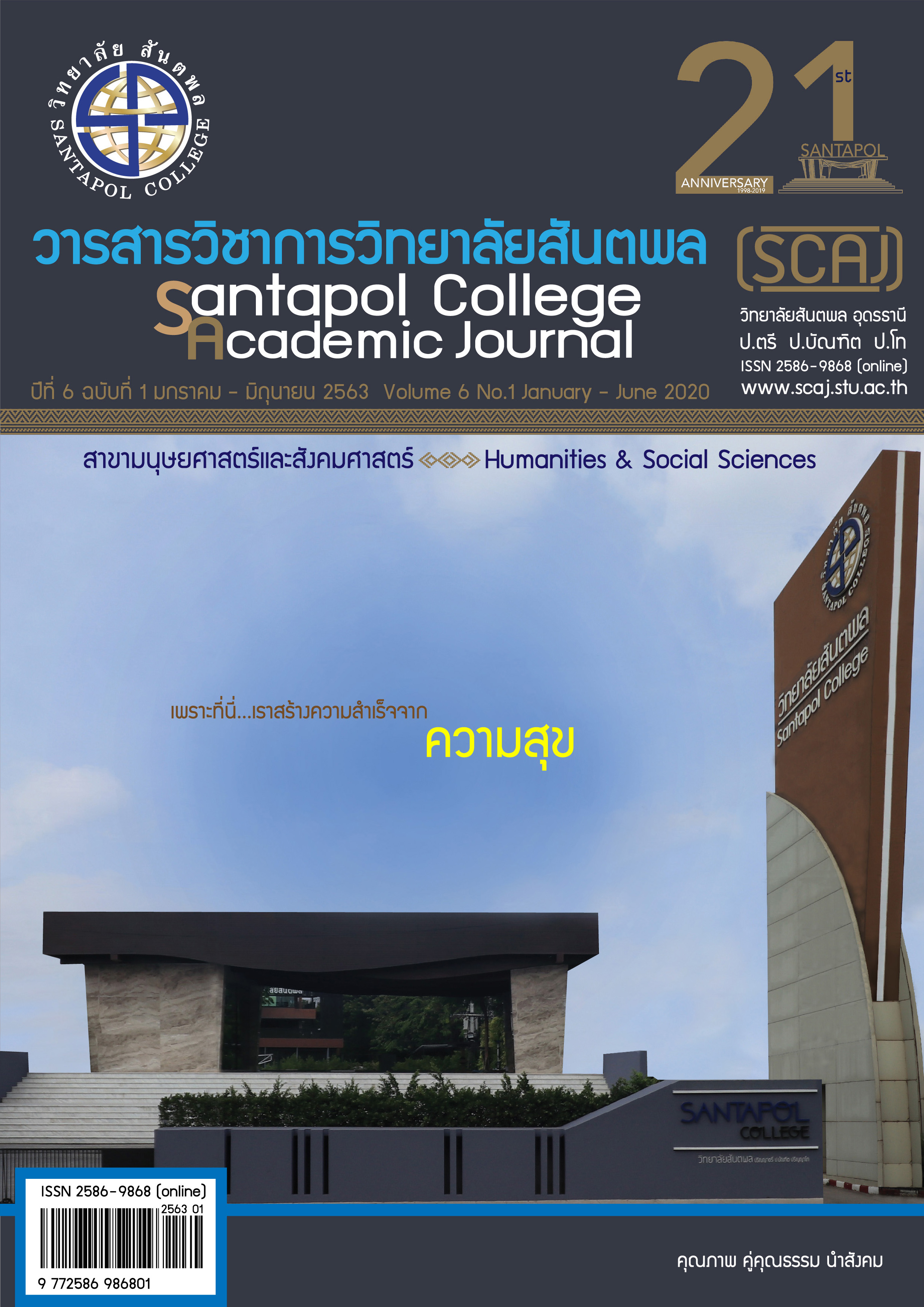การพัฒนาแบบวัดการรับรู้สมรรถนะแห่งตนของนักศึกษาคณะครุศาสตร์ มหาวิทยาลัยราชภัฏ บ้านสมเด็จเจ้าพระยา: การทดสอบความไม่แปรเปลี่ยนในการวัดระหว่างเพศ Test of Gender Invariance
Main Article Content
บทคัดย่อ
การวิจัยนี้มีวัตถุประสงค์เพื่อ 1) พัฒนาแบบวัดการรับรู้สมรรถนะแห่งตนที่มีความเที่ยงและความตรงเชิงโครงสร้าง
2) ทดสอบความไม่แปรเปลี่ยนของแบบวัดการรับรู้สมรรถนะแห่งตนระหว่างเพศ กลุ่มตัวอย่างคือนักศึกษาที่กำลังศึกษาใน คณะครุศาสตร์ มหาวิทยาลัยราชภัฏบ้านสมเด็จเจ้าพระยาจำนวน 240 คน โดยใช้การสุ่มแบบ 3 ขั้นตอน เก็บรวบรวมข้อมูลโดยใช้แบบสอบถามข้อมูลส่วนบุคคลและแบบวัดการรับรู้สมรรนะแห่งตน โดยมีค่าความเที่ยงเท่ากับ 0.93 วิเคราะห์ข้อมูลด้วย ความถี่ ร้อยละ ค่าเฉลี่ย ส่วนเบี่ยงเบนมาตรฐาน ค่าสัมประสิทธิ์สหสัมพันธ์เปียร์สันและการวิเคราะห์องค์ประกอบเชิงยืนยันพหุกลุ่ม
ผลการวิจัยพบว่า 1) แบบวัดการรับรู้สมรรถนะแห่งตนมีความเที่ยงสูงโดยมีค่าความเที่ยงเท่ากับ 0.93 และผลการวิเคราะห์องค์ประกอบเชิงยืนยันพบว่าโมเดลการรับรู้สมรรถนะแห่งตนมีความตรงเชิงโครงสร้าง (c2=4.30, df=4, p-value=0.37, AGFI=0.97 CFI=1.00, RMSEA=0.00) 2) แบบวัดการรับรู้สมรรถนะแห่งตนมีคุณสมบัติไม่แปรเปลี่ยนในการวัดระหว่างเพศแบบเคร่งครัด
Article Details

อนุญาตภายใต้เงื่อนไข Creative Commons Attribution-NonCommercial-NoDerivatives 4.0 International License.
เนื้อหาและข้อมูลในบทความที่ลงตีพิมพ์ในวารสารวิชาการวิทยาลัยสันตพล ถือว่าเป็นข้อคิดเห็นและความรับผิดชอบของผู้เขียนบทความโดยตรง ซึ่งกองบรรณาธิการวารสารไม่จำเป็นต้องเห็นด้วยหรือรับผิดชอบใดๆ
เอกสารอ้างอิง
[2] Bandura, A. (1997). Self-efficacy: The exercise of control. New York. Freeman and Company.
[3] Luszczynska, A., Scholz, U., & Schwarzer, R. (2005). The general self-efficacy scale: multicultural validation studies. The Journal of psychology. 139(5). 439-457.
[4] Luszczynska, A., Benight, C. C., & Cieslak, R. (2009). Self-efficacy and health-related outcomes of collective traum6a: A systematic review. European Psychologist, 14(1), 51-62.
[5] Lu, C. Q., Du, D. Y., & Xu, X. M. (2016). What differentiates employees' job performance under stressful situations: The role of general self-efficacy. The Journal of psychology. 150(7). 837-848.
[6] Yu, X., Wang, P., Zhai, X., Dai, H., & Yang, Q. (2015). The effect of work stress on job burnout among teachers: The mediating role of self-efficacy. Social Indicators Research. 122(3); 701-708.
[7] Çelik, O. T., & Kahraman, Ü. (2018). The Relationship among Teachers' General Self-efficacy Perceptions, Job Burnout and Life Satisfaction. Universal Journal of Educational Research. 6(12). 2721-2729.
[8] Schwarzer, R., & Jerusalem, 8M. (1995). Generalized Self-Efficacy scale. In Johnston, M., Wright, S., & Weinman, J. (Ed.), Measures in health psychology: a user's portfolio, (35-37). Windsor. NFER-NELSON.
[9] Jerusalem, M., & Schwarzer, R. (1992). Self-efficacy as a resource factor in stress appraisal processes. In Schwarzer, R. (Ed.), Self-efficacy: Thought control of action, (195-213). Washington, DC. Hemisphere.
[10] Romppel, M., Herrmann-Lingen, C., Wachter, R., Edelmann, F., Düngen, H. D., Pieske, B., & Grande, G. (2013). A short form of the General Self-Efficacy Scale (GSE-6): Development, psychometric properties and validity in an intercultural non-clinical sample and a sample of patients at risk for heart failure. GMS Psycho-Social-Medicine. 10. Doc01. doi:10.3205/psm000091
[11] Sukmak, V., Sirisoonthon, A., & Meena, P. (2001). Validity of the general perceived self-efficacy scale. J Psychiatr Assoc Thailand. 47(1). 31-37.
[12] Milfont, T. L., & Fischer, R. (2010). Testing measurement invariance across groups: Applications in cross-cultural research. International Journal of psychological research. 3(1). 111-130.
[13] Hirschfeld, G., & Von Brachel, R. (2014). Multiple-Group confirmatory factor analysis in R-A tutorial in measurement invariance with continuous and ordinal indicators. Practical Assessment, Research & Evaluation. 19(7). Available online: https://pareonline.net/getvn.asp?v=19&n=7
[14] Preacher, K. J., & Coffman, D. L. (2006). Computing power and minimum sample size for RMSEA [Computer software]. Available online: https://quantpsy.org
[15] Simms, L. J., Zelazny, K., Williams, T. F., & Bernstein, L. (2019). Does the number of response options matter? Psychometric perspectives using personality questionnaire data. Psychological assessment. 31(4). 557-566.
[16] Boomsma, A., & Hoogland, J. J. (2001). The robustness of LISREL modeling revisited. Structural equation models: Present and future. A Festschrift in honor of Karl Jöreskog. 2(3). 139-168.
[17] Schreiber, J. B. (2017). Update to core reporting practices in structural equation modeling. Research in Social and Administrative Pharmacy. 13(3). 634-643.
[18] Hair, J. F., Black, W. C., Babin, B.J., Anderson, R. E. and Tatham, R. L. (2006). Multivariate Data Analysis (6th ed.). New Jersey. Prentice Hall.


